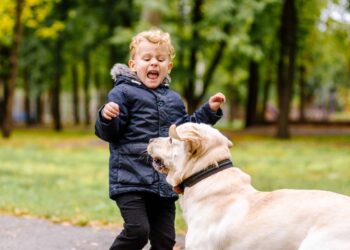Dogs are not just pets; they are family members, bringing joy and love into our lives. But just like humans, dogs have different personalities and temperaments. What doesn’t bother one dog may be very stressful for another.
It’s not uncommon for dogs to experience periods of sadness and it can be challenging for pet owners to understand why their furry friend is feeling down. If you think your pup is feeling blue, learn to recognize the signs and triggers and find out how to keep them mentally and emotionally healthy and happy.
Dogs and Feelings
Dogs are capable of experiencing a range of emotions, including happiness, fear, anger and sadness. According to neuroscientist Gregory Burns, dogs get sad but don’t have words to describe how they feel. While their emotions are real, they are far less nuanced than human emotions because their brains are smaller.
Dogs may show these emotions through body language, such as the position of their tail, the look on their face and body posture. They also express their emotions through vocal cues, such as barking, growling and whining.
If your pup is sad, it could be a symptom of a physical injury, a poor diet or an indication of depression. Understanding your dog’s emotions and recognizing when they are sad or anxious is essential to being a responsible and loving pet owner.
Reading Suggestions: Microphthalmia in Dogs: Symptoms, Diagnosis, and Treatment
Signs of a Sad Dog
Although the symptoms will vary depending on the individual dog and the severity of the problems, several signs may indicate that your dog is sad. These can include changes in behavior such as:
- Lethargy
- Loss of appetite
- Reduced interest in activities they used to enjoy
- Clinginess and attention seeking
- Becoming more vocal or quieter than usual
- Overgrooming
- Changes in sleep patterns
- Avoidance of people
- Being destructive
- Becoming withdrawn
Physical signs of sadness in dogs include droopy ears, a lack of tail wagging and a general disinterest in activities they typically enjoy.
Sad Dog Triggers
Many factors can impact your pet’s emotional state, such as changes to their routine, social group and environment and anxiety from fears or phobias. The following are common triggers that may make your dog feel sad:
Separation Anxiety
Dogs are social animals and enjoy being around their owners and other people. When they are left alone for long periods, they may become anxious and sad. Avoid leaving your pup alone for more than 4 hours without checking in and giving them attention.
Lack Of Exercise
Dogs need physical and mental stimulation to stay happy and healthy. If they are not getting enough exercise, they may become bored and sad. Working breeds especially suffer from boredom, resulting in behavior problems and dog depression. Huskies, German Shepherds and Great Danes are working dogs that often feel sad due to boredom.
Change In Routine
Dogs thrive on routine and any changes to their schedule can cause stress and sadness. This can include changes in their diet, sleep schedule or living environment, such as moving home.
Illness Or Injury
If your dog is experiencing pain or discomfort due to illness or injury, it may become sad and withdrawn. Give your pup extra love and care if they are recovering from an illness or injury to prevent sadness.
Grief
Dogs can experience grief and loss just like humans. They may become sad and lethargic if they have lost a companion or family member and require extra attention.
Fears and Phobias
Even if they’re not showing any obvious signs of fear, a dog that suffers from separation anxiety or a noise phobia may always be in a state of stress and look sad. Try to learn what might trigger your dog and implement changes to help.
Reading Suggestion: Solving Common Dog Behavior Issues
Ways to Cheer Up Your Sad Dog
If your dog is exhibiting signs of being unhappy or is showing significant behavioral changes, consider taking them to the vet for a check-up. Your veterinarian can diagnose and treat any underlying health problems that may be causing your dog’s low spirits.
Provide comfort
Your dog needs extra love and attention when feeling sad. Spend time cuddling, petting and talking to your dog. This helps ease their anxiety and makes them feel loved.
Increase exercise
Increasing your dog’s exercise improves its mood and reduces stress. Take your dog for long walks, play games with them or take them to a park to run and play.
Stick to a routine
Keeping a consistent routine reduces your dog’s stress levels. Make sure they are eating, sleeping and playing at the same time each day.
Consider medication
In some cases, medication may be necessary to help your dog overcome its sadness. Your veterinarian can advise you on the best treatment for your dog’s needs.
Ensure they are eating
Adding a wet dog food topper with sustainable vegetables and savory sauces to their kibble can encourage your dog to eat. Using a topper is also a great way to introduce new food slowly, avoiding digestive issues.
The Impact of Nutrition on Your Pup’s Mental Health
Your canine companion requires a balanced diet for optimal health and well-being. A diet lacking in essential nutrients can lead to poor health and feelings of sadness due to the following:
- An inadequate diet can cause intestinal problems for your pet, causing them to exhibit signs of anxiety.
- Too much of the wrong type of fat results in obesity, lethargy, heart problems and diabetes.
- Dogs fed too much cereal, like wheat and corn meal, may be unfocussed or agitated. Look for dry dog food with no wheat, corn or soy, no artificial flavors or preservatives and humanely raised protein like chicken with no antibiotics.
- Some dogs don’t get the amino acids they need to thrive because they can’t digest incomplete proteins, causing your pup to chew on furniture and other objects. Freeze dried dog food is a great way to ensure your pup gets the protein they need. Look for products formulated with humanely raised protein with no filler materials.
By switching to a nutritionally appropriate diet for their size, health, age and activity level, your pup will return to its usual vigor, providing you with many more years of companionship and unconditional love.
Getting Your Dog Back to Normal
Dogs can experience sadness for many reasons. As a pet owner, it is essential to understand why your dog is feeling down and provide them with the love, comfort and care they need to get through it. If your dog’s mood or behavior changes, visit your vet to check for clinical causes.
Once your pet has a clean bill of health and you still can’t resolve why their mood is so low, consider reaching out to a certified animal behaviorist who can help you transform your dog’s mood and life for the better. With patience and understanding, your dog will soon be back to its happy, playful self.








